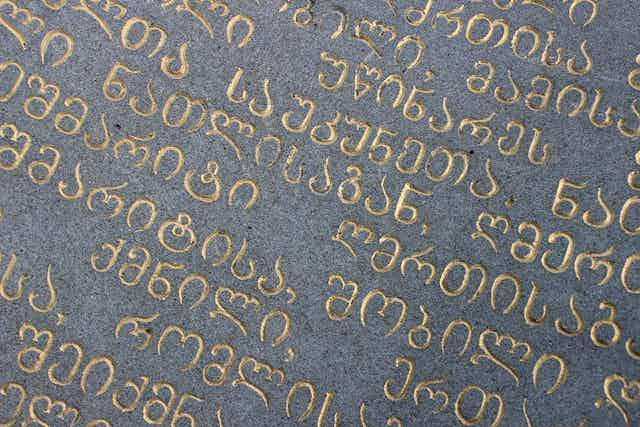The BBC’s latest drama series, an adaptation of China Miéville’s 2009 novel The City and The City, is a police procedural – but with a difference. The series is set in a fictitious divided city – Besźel and Ul Qoma – where the residents of each side are allowed no contact with each other. The main character, Inspector Tyador Borlu (played by David Morrissey), is a resident of Besźel – a slightly grubby, down-at-heel kind of place. During an investigation, he has to travel to the other city, Ul Qoma, and in order to heighten the difference for both the character and the audience, the Ul Qoman language of Illitan had to be completely different.
This is where I came in. As a linguist, I was called in to design a distinctive language for the series. This is not as uncommon as it sounds – there have been a number of languages created over the years, for various reasons. The American linguist Arika Okrent lists 500 in her book In the Land of Invented Languages which goes well beyond the usual suspects of Esperanto, Elvish and Klingon.
Constructed languages, or conlangs, have been gaining popularity in recent years, with their own society, the Language Creation Society, and annual conference. The seventh annual conference was held in July 2017 in Calgary – and even a brief look at the schedule of talks will tell you that these people take language construction extremely seriously (“(Ab)using Construction Grammar (CxG) as a Conlanging Tool”) but also have a sense of humour (“Someone from That Planet Might Be in the Audience”).
Of course, J.R.R. Tolkien created languages for Lord of the Rings – and there is a huge amount of detail on those languages for anyone with enough interest to pursue it. But in what is now widely regarded as the golden age of television, with multiple providers needing content for their channels, there is a broader scope for invention and fantasy – which is where language invention comes into its own.
The most famous example of a language created specifically for film and television is Klingon, originally created by Marc Okrand for Star Trek II: The Wrath of Khan. Klingon has since taken on a life of its own, with a Klingon Language Institute and translations of Hamlet and Much Ado About Nothing. More recently, HBO’s television adaptation of the Game of Thrones books required the creation of the Dothraki and Valyrian languages, for which David J. Peterson was responsible.
Talking points
While Tolkien left some fairly detailed instructions regarding the structure and vocabulary of Elvish, most authors do not go into such detail. George R.R. Martin makes reference to the languages in his Game of Thrones novels, but Peterson created them. Likewise, while Miéville gives a number of hints about the sound and structure of Illitan, there was no grammar or dictionary to refer to. Having free rein to create a language – not purely as an academic construct, but one which will be used – is both a challenge and a joy.
The primary concern for what we might term “artistic” language creators is the ease of pronunciation for the actors. If we are being asked to produce a human language, then we have the luxury of our previous study of language and linguistics to guide us. If asked to create an alien language – as Okrand was – there might be limitless possibilities, but the actors still have to be able to physically say the lines; we are constrained by human physiology. This was not an issue in the adaptation of Story of your Life by Ted Chiang (which was filmed using the title Arrival), as the aliens communicated telepathically – although the writing system had to be created by the design team.

Script reading
In his novel The City and The City, Miéville tells us that Illitan uses the Roman script, having lost its original, right-to-left script “overnight” in 1923 (we’re not told how or why). We know that Borlu finds the sound of Illitan “jarring” (although we know from Miéville’s description of the character that he speaks “good” Illitan). In Besźel, meanwhile, people speak Besz, but for the purposes of the TV adaptation this is rendered as English and the written language, despite its occasional Cyrillic intrusions and diacritics (accents, for example), is still understandable to an English-speaking audience.
In order for the audience to share in Borlu’s sense of alienation in Ul Qoma, the decision was taken to use an entirely different alphabet for Illitian for the television series – and we eventually settled on the Georgian alphabet as it bears no resemblance to English.
The grammar of Illitan is made up of a mixture of Slavonic languages (such as Slovene, with its extra verb conjugation referring to two people: “we two are”, “you two are”, “they two are” as well as “we are”, “you are”, “they are”) and a system of infixes (like a prefix, but it fits into the word rather than in front of it) to denote tense and aspect. The word order remained roughly the same as English in order to help the actors know where to put the emphasis in their lines.

One final problem when creating a language from a novel is one familiar to any adaptation – the expectations of the audience. With any adaptation, the audience is divided into those who know the original novel and those who do not. Those who do will always have their own ideas about how the characters look and sound – and this extends to fictional language.
My version of Illitan will not necessarily match up with that of a fan of The City and The City, but I hope it will add something for people who are new to Miéville’s work.

